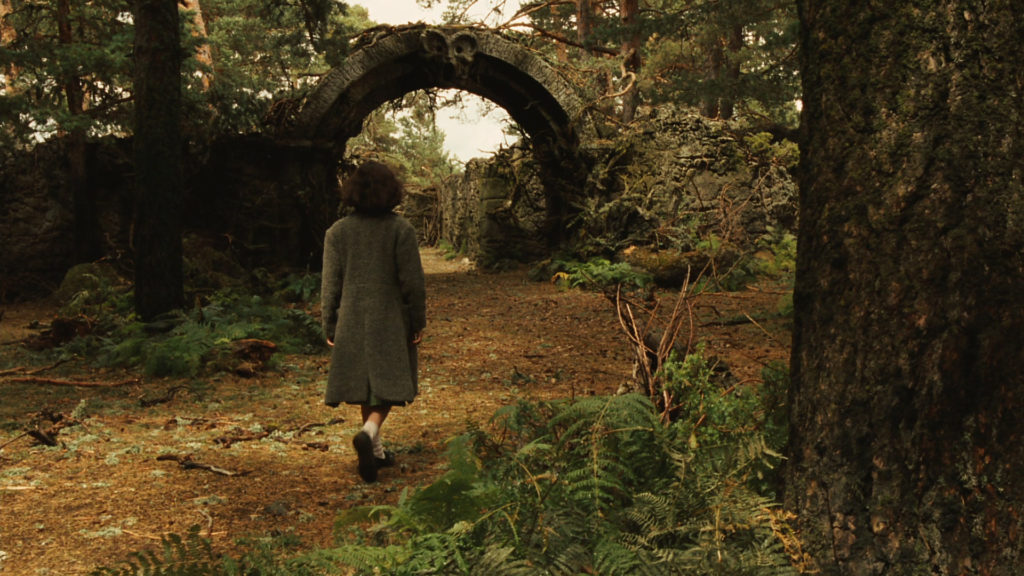Three Lost Girls In Poetic Peril
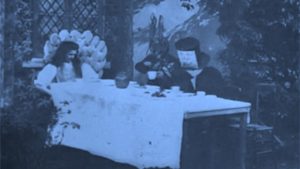 In connection with ZekeFilm’s early summer “fairy tale” theme – and more particularly with this month’s Film Admissions article on the subject – I have decided to organize my home-viewing schedule in the waning days of June around some mythic movie-watching fare of my own. And since my movie-writing criteria tends to naturally (perhaps too naturally) organize itself around any title that suitably ends with an exclamation point(!), I settled on a subject equally suitable to the fever pitch of broiling emotion and over-caffeinated intensity brought to a boil – by an otherwise quiet and unassuming personality, I should add – during the hottest days of the year. In this somewhat overzealous spirit, then, I have settled on A TRIO OF FAIRY TALE TERROR!
In connection with ZekeFilm’s early summer “fairy tale” theme – and more particularly with this month’s Film Admissions article on the subject – I have decided to organize my home-viewing schedule in the waning days of June around some mythic movie-watching fare of my own. And since my movie-writing criteria tends to naturally (perhaps too naturally) organize itself around any title that suitably ends with an exclamation point(!), I settled on a subject equally suitable to the fever pitch of broiling emotion and over-caffeinated intensity brought to a boil – by an otherwise quiet and unassuming personality, I should add – during the hottest days of the year. In this somewhat overzealous spirit, then, I have settled on A TRIO OF FAIRY TALE TERROR!
“Three Lost Girls in Poetic Peril” seemed a good point of departure in the half second between dreaming up the title and instantly regretting a further movie-related commitment, and three movies – in that moment wavering between cinema-inspired excitement, remorse, and resolve – again naturally suggested itself to my monomaniacal, movie-addled brain: in particular, Jean Renoir’s early silent screen fantasy The Little Match Girl, Jonathan Miller’s mid-60s BBC TV-adaptation of Alice in Wonderland, and – one I had long-desired to see, but had yet to access a copy of – the Czech New Wave art-horror fairy tale Valerie and Her Week of Wonders.
A long-overdue notification from my local library branch that they had finally located an out-of-state DVD of the lattermost selection – the preferred 2015 pressing by the Criterion Collection – clinched my by-now firm resolve to follow through on my always-wobbly intentions, and I have sat down to write this introduction having already re-viewed 2/3rds of my self-inflicted fairy tale-themed triple feature. Though said intentions may radically change after seeing what young Valerie’s Week of Wonders has in store for the poor lass – by all accounts an immersive, haunting viewing experience – I would hope her to be a logical companion to the suffering, dreaming Match Girl and the listless, similarly-dreaming Alice.
For it is in dreams that the world of story and the world of fairy tales share a common, though far from firm, ground; the passage between a child’s imagination towards adult awareness perhaps most admirably finding its uneasy visual analogue in the dream-like state of watching movies. Yes, for the three reels or hour-and-a-half we follow them about, these fairy tale children may be “lost” between growing consciousness and diminishing innocence, but the transition portrayed by these dramas of ripening emotion remind us that childhood’s end is a threshold through which we all must – eventually – pass; frightening though the prospect may initially seem. As these selections show, there’s nothing scarier, nothing more purely terrifying than simply growing up!
Lost Girl #1: THE LITTLE MATCH GIRL
(1928, France, dir. Jean Renoir)
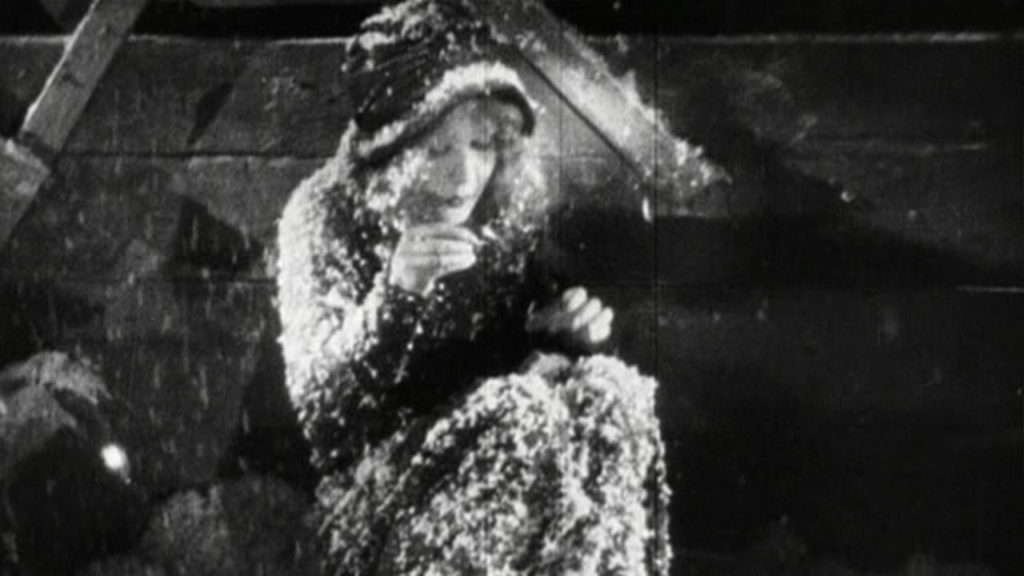
Director Jean Renoir’s early flirtation with fantasy and surrealism stars his then-wife Catherine Hessling – who had been artist’s model for Renoir’s father, the Impressionist painter Pierre-Auguste Renoir – in both an updating and subversion of the famous Hans Christian Andersen story. Removing some of the more sentimental and comforting aspects of the original – this three-reel adaptation, for instance, excises the fairy grandmother-like figure who ushers the impoverished girl into heaven – what’s left is the bare bones narrative of the title’s Little Match Girl who, on a cold New Year’s Eve, has a rapturous vision of all the joy and wonderment she has been denied her short life in the instant before freezing to death.
Rather bleak material for a fairy tale, one must admit, but the charming, ebullient screen personality of Ms. Hessling – which had been demonstrated to great if disastrously unprofitable effect in Renoir’s first features Whirpool of Fate (1925) and Nana (1926) – sympathetically carries the fantasy between the character’s drudge-like existence in the real world, trudging the streets to the indifference and ridicule of the townspeople, and the glowing and emotionally overwhelming realm of imagination to which she effectively “escapes”. Dancing, cavorting, and even juggling(!) her way into some place quite Other – a vividly-realized, consumerist’s dream-world where a toy store’s window display of outsize baubles and life-size dolls springs to life – our Little Match Girl would seem in the film’s second reel to have wondrously transcended the harsh realities of extreme deprivation and poverty through her imaginings. Indeed, we the viewer may even momentarily forget that this lovely interlude is but a wavering hallucination within a flickering match which has insubstantially failed to staunch the creeping onset of hypothermia!
And so, as a lovely tea party with her real-life policeman “protector”, who in her vision appears as an oversize tin soldier (Jean Storm), is broken up by the martial-like appearance of Death himself (Manuel Raaby) – complete with his feather-festooned helmet’s skull-and-crossbones insignia – a cloud-stalking chase on horses across the sky ensues in the film’s third reel, the Little Match Girl’s protector fatally falls to his doom, and the by-now strangely sympathetic figure of Death tenderly lays the dying girl to rest in a celestially blooming briar patch. Awakening to her own death in the “real world” – falling snow gently caressing her eyelids as the cruel townspeople cluck their monstrous disapproval – one very well may get the sense that our Little Match Girl has indeed left childhood behind: if only to both literally and figuratively “commune” with Death!
Lost Girl #2: ALICE IN WONDERLAND
(1966, BBC, dir. Jonathan Miller)
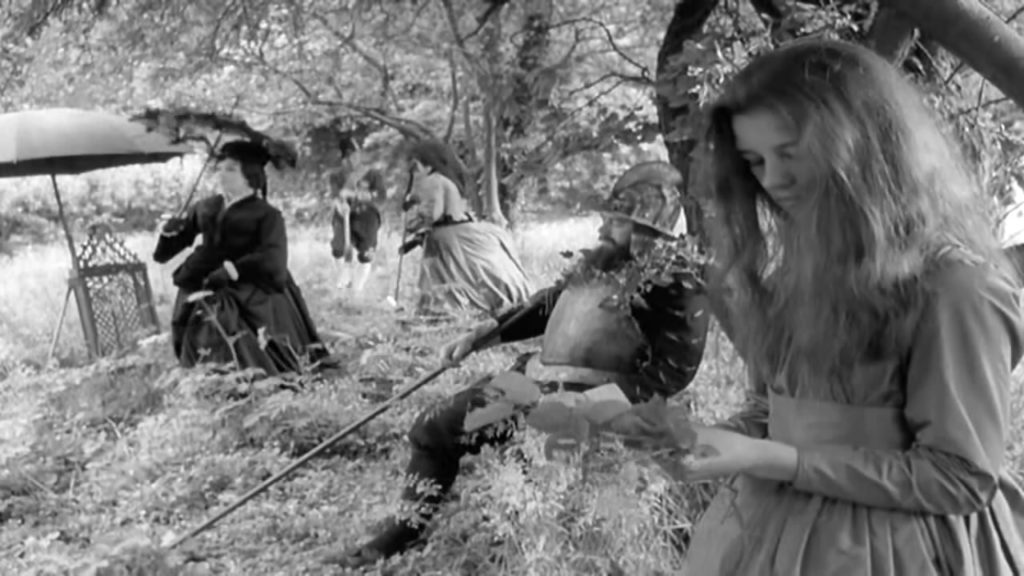
Jumping ahead about 40 years, our next screen fantasy – and by extension our next Lost Girl – is possibly the progenitor of all similarly-themed screen fantasies. Lewis Carroll’s 1865 children’s classic was first filmed in 1903, and received about thrice as many playfully antic and fancy dress adaptations as there were decades in the interim (including the Walt Disney animated version of 1951) until former Beyond the Fringe performer Jonathan Miller – later to essay the ultimate in small screen horror with his adaptation of M.R. James’ Whistle and I’ll Come to You (1968) – resolved to put a definitive end to all this stuff and nonsense with his own terrifying televisual take on the definitive fairy tale.
With fellow Beyond the Fringe members Peter Cook and Alan Bennett on hand – playing a simpering and insensate Mad Hatter and a droning and drily pedantic Mouse, respectively – Miller’s adaptation is a triumph of casting: major roles are rounded out by some of the grand luminaries of the day, including Wilfrid Brambell (as the White Rabbit), Michael Gough (as the March Hare), Michael Redgrave (as the Caterpillar), Leo McKern (as the Ugly Duchess), John Gielgud (as the Mock Turtle), Peter Sellers (as the King of Hearts), and Alison Leggatt (as the Queen of Hearts). Moreover, unlike any version made before (or since, for that matter), the actors appear as themselves, without animal heads or elaborate costumes, against startlingly realistic though vaguely surrealistic mid-Victorian country houses, landed estates, and variously imposing architectural oddities. Along with the expansive parks and seashores that filled the popular landscape paintings – and, indeed, the nascent amateur photography – of the mid-nineteenth century, director Miller takes frightening advantage of such notable period locations as an unnervingly vast abandoned hospital and a drawing room-library with a swirling whirlpool opening disconcertingly beneath its floors.
Aiming to capture those “long, interminable summer days of extreme youth”, ably abetted by sitar-master Ravi Shankar’s effectively languid score, the familiar tea and garden parties of the original receive off-center and somewhat sinister framing through distorting angles, wide-angle compositions, and a black-and-white visual style keenly reminiscent, though as creepily otherworldly, of early daguerreotypes or glass plate-prints. At the center of the equally menacing word games, logic-subverting puzzles, and dizzying absurdities – the script is taken nearly word for word from the original text, one scene dissolving into the next like an especially lucid dream – is sullen, listless, dreaming Alice who, as played by one Anne-Marie Mallick, captures perfectly the presumed historical child the Rev. Charles Dodgson observed wandering dazedly about Christ College, Oxford and its environs. Struggling – and undoubtedly failing – to understand a dry and dusty academia and its foolish and fusty personalities, “Wonderland” may be nothing more terrifying than a child’s eye view of the bewildering world of adulthood!
Lost Girl #3: VALERIE AND HER WEEK OF WONDERS
(1970, Czechoslovakia, dir. Jaromil Jires)
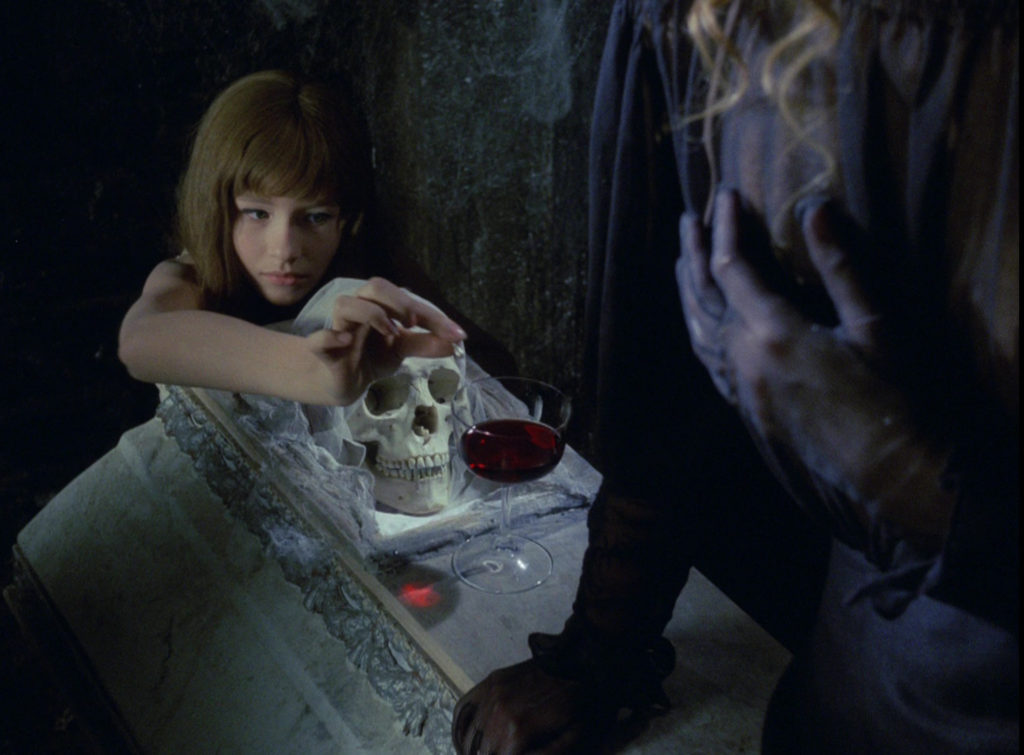
If the BBC Alice represents a 60s-zeitgeist screen nightmare, then the Czech New Wave Valerie evokes some incomprehensible netherworld beyond nightmare. Part folktale, part vampire story, part art film, horror movie, and even soft-core erotica, Valerie and Her Week of Wonders is, as related by film scholar Peter Hames, “all and none of these”, encompassing a tradition of the avant-garde designed to both shock and amaze in equal measure; to push its viewer, as described in an earlier entry, into the realm of something quite Other. And my viewing of this rather overwhelming fantasy the night before last, I must admit, has left me quite stymied as exactly how to accurately describe it!
Opening on a lyrical pastoral scene of a young girl traipsing through a meadow, a bewildering sequence of events, or “spells” as they are later referred to, are set off by young Valerie (Jaroslova Schallerova) and her entrance into womanhood, symbolized – and literalized – by the haunting image of bright-red blood dripping onto the petals of a flower. Set in a vaguely medieval-seeming though specifically nineteenth century-timed Central European never-land, what follows is a fairy tale drama of a grandmother (Helena Anyzova) and her pure-white home, along with the colorful street processions, sun-glazed fruit, green-lit woodland idylls, pearl-shaped magical charms, and equally magical resurrections that cast a further lyrical spell on its viewer. Also dealt with, though, are many of those deeper, darker elements inescapably present in the otherwise lightest dreamscapes of Monsieur Perrault and Herren Grimm, including lost parents, gothic dungeons, dramatic reversals, horrifying deaths, and frank flirtation with all unsavory manner of taboo.
And (AND!) there’s vampires! Though a perverted priest (Jan Klusak) might seem an easy villain to pass by a Communist Board of Censors, the Nosferatu-like Polecat (Petr Kopriva) – enacting roles as varied as the town constable, the church bishop, a lost lover, and a dead father – is a Protean, amorphous screen monster unlike any other: chalk-faced, black-robed, velvet-gloved; fan-waving, whip-cracking, pistol-whipping; with a jagged leer of yellowed, razor-sharp teeth designed to give even the staunchest of orthodontists nightmares for a solid month. (The very sight of him stalking Valerie in the street and suddenly swooping down to enfold her in his shroud-like robe was enough to give me a nightmare or two.)
All in all, a dizzying dream of a fantasy film that is quite unlike anything even this Slightly Obsessed viewer has ever seen. Like those headier tales of yore, characters, plot points, and even settings merge, shift, and transform before the viewer’s alternately confused, delighted, and terrified eyes, lulling one into a trance-like state best befitting the Long Ago and the Far Away.
Post-VALERIE!
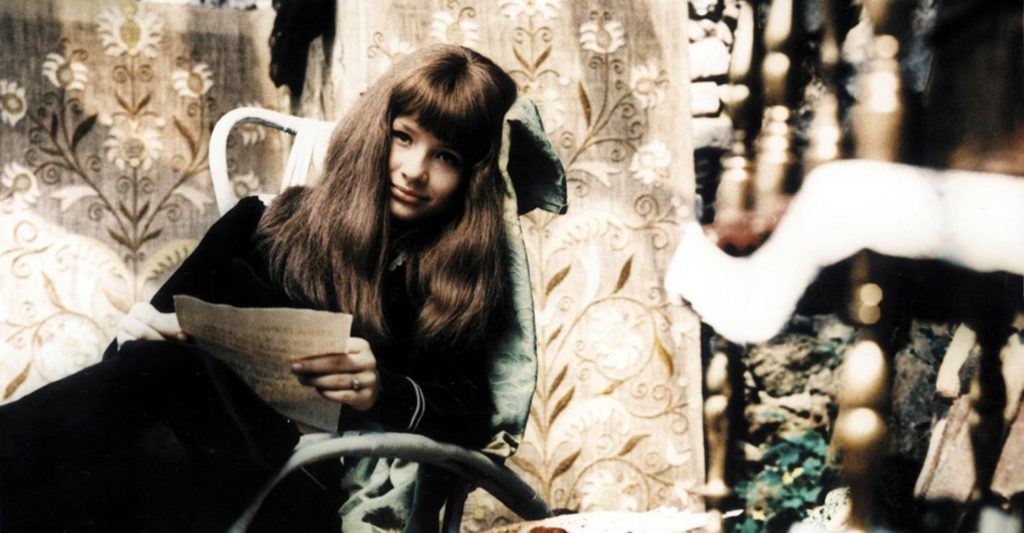
Though I obviously did not know what to expect when I paired the unseen Valerie with Alice and the Little Match Girl, the first movie I immediately thought to view as follow up was Dario Argento’s Snow White-variation in a German dance academy/witch’s coven; i.e., the masterful fairy tale-giallo Suspiria (1977). And really, if I were to consider this movie/fairy tale theme much longer, I might also include the recently-rediscovered Japanese splatter horror/comedy House (1977), the Little Ride Riding Hood-variant The Company of Wolves (1984), the horror-revisionist Snow White: A Tale of Terror (1997)… and probably countless others.
For it occurs to me that fairy tales in all their myriad forms, and these forms in particular – all the namesake “lost girls” – are part of a long, near-eternal river-flow of narrative that endlessly reflects and returns upon something deep and enduring about the most universal of human experiences. Realized in screen vision after screen vision – and I’ve just thought of another: an Alice-redux courtesy of a visionary Guillermo del Toro in Pan’s Labyrinth (2006) – one might assume that the best screen fantasies about growing up are also the most honest; and therefore the scariest!
At least according to this viewer.
